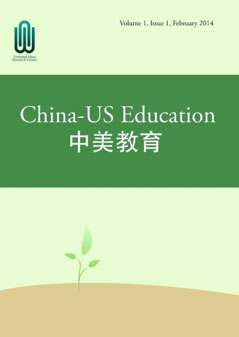


Volume 10 Issues 3-4 (2023-12-31)
Volume 10 Issue 1 (2023-03-31)
Volume 8 Issues 1-3 (2021-10-31)
Volume 7 Issues 3&4 (2020-12-31)
Volume 7 Issues 1&2 (2020-06-30)
Volume 6 Issues 3&4 (2019-12-31)
Volume 5 Issues 1-3 (2018-06-30)
Volume 4 Issues 3&4 (2017-08-31)
Volume 4 Issues 1&2 (2017-04-30)
Volume 3 Issues 5&6 (2016-12-31)
Volume 3 Issues 3&4 (2016-08-31)
Volume 3 Issues 1&2 (2016-04-30)
Volume 2 Issues 5&6 (2015-12-31)
Volume 2 Issues 3&4 (2015-08-31)
Volume 2 Issues 1&2 (2015-04-30)
Volume 1 Issues 5&6 (2014-12-31)
The purpose of this study was to investigate significant differences in Chinese college students’ contingences of self- worth. A total 414 college students studying at an eastern university in China participated in this study. The scale measuring contingencies of self-worth developed by Yang (2008) was adopted for this study. It measures the degree of contingency of self-worth in college students in six aspects: ability and knowledge, behavioral style, habitus and appearance, social status, country and nation, and family and parents. Using SPSS, descriptive and inferential statistical analyses were performed. The results indicated that data were analyzed at two different levels to answer the two research questions. Results indicated that these participants demonstrated high degree of contingencies of self-worth in behavioral style as well as ability and knowledge. Significant group differences were found.
This study analyzes diversity and inclusion across a sample of educational institutions in Ontario. Concepts developed by Mor Barak (2011) were used as a foundation for the researchers’ framework that is centered on the Inclusion Skills Measurement Profile (ISM) developed by Turnbull, Greenwood, Tworoger, and Golden (2010) to examine a spectrum of criteria considered to be indicators of organizational diversity.
“Character is what you do when no one is watching” so the wise sages say. In the relatively new cyber world who is really watching? Data indicates that in the anonymous realm of the cyber-space, people feel invisible and thus may act in a manner that they normally would not in person. Many times this behavior involves illegal or often times violent actions. Cyber-bullying has become an epidemic, affecting schools and workplaces alike. This paper discusses the ethical principles of cyber conduct and the issue of positive cyber-citizenship. Cases of cyber related violence are increasing at an alarming rate and school age children are using computers and the internet to inflict damage and harm to others. Attention is being given to school violence occurring through the use of firearms, however damage and injury is being inflicted on far greater numbers of school age children through the use of computers. These acts, whether as a result of mischief or intentional desire to cause injury, need to be studied and understood, and principles of cyber ethics need to be adopted